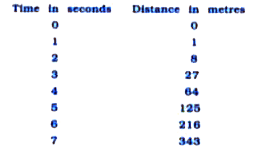A force of 5N produces an acceleration of 8 ms in an object of mass m1, and produces an acceleration of 24 m s−2 in object of mass m2. What acceleration would be produced if both the masses were tied together and applied force would be 5 N.Solution in Gujrati
6ms−2
Topper's Solved these Questions
- BOOK - KUMAR PRAKASHANCHAPTER - FORCE AND LAWS OF MOTIONEXERCISE - Question based on pracctical skill with answers(Select the appropriate option and complete the sentence :)4videos
FORCE AND LAWS OF MOTION
- BOOK - KUMAR PRAKASHANCHAPTER - FORCE AND LAWS OF MOTIONEXERCISE - Additional Exercise4videos
FORCE AND LAWS OF MOTION
- BOOK - KUMAR PRAKASHANCHAPTER - GRAVITATIONEXERCISE - ACTIVITY 10.42videos
GRAVITATION
Similar Questions
Newton's II law of motion connects:
03:11View SolutionThe following is the distance-time table of an object in motion:

(a)What conclusion can you draw about the acceleration ?Is it constant. Increasing decreasing ir zero? (b)What do you infer about the force acting on the object?04:47View SolutionTake an empty plastic bottle . Close the mouth of the bottle with an airtight stopper . Put it in a bucket filled with watere . The bottle floats .
Push the bottle into the water. You feel an upward push. Try to push it further down. You will find it difficult to push deeper and deeper. Water exerts a force on the bottle in upward direction. Now release the bottle. It bounces back to the surface.
Does the force due to the gravitational attraction of the earth act on this bottle? If so, why doesn't the bottle stay immersed in water after it is released ?03:16View SolutionA force of 5N gives a mass m1, an acceleration of m/s2, and a mass m2, an acceleration of 24m/s2. What acceleration would it give if both the masses are tied together?
02:52View SolutionDerive the unit of force using the second law of motion. A force of 5N produces an acceleration of 8ms−2 on a mass m1 and an acceleration of 24ms−2 on a mass m2. What acceleration would the same force provide if both the masses are tied together?
04:13View SolutionA force of 5N gives a mass m1, an acceleration of 10m/s2, and a mass m2, an acceleration of 20m/s2. What acceleration would it give if both the masses were tied together?
04:35View SolutionA force of 2N gives a mass m1 an acceleration of 5m/s2 and a mass m2 an acceleration of 7m/s2. What acceleration would be produced if both the masses are tied together?
03:21View Solutionकिसी द्रव्यमान m1 पर 5 N का बल लगाने पर 8m/s2 का त्वरण उत्पन्न होता है जबकि इसी परिमाण का बल द्रव्यमान m2 में 24m/s2 का त्वरण उत्पन्न करता है। यदि दोनों द्रव्यमान को परस्पर बाँधकर एक कर दिया जाए, तो इस बल द्वारा संयुक्त द्रव्यमान में कितना त्वरण उत्पन्न होगा ?
03:02View SolutionA force of 5 N gives a mass m_(1) an acceleration of 8m//s^(2) and a mass m_(2) an accleration of 24 m//s^(2) . What acceleration would it give if both the masses are tied together?
04:25View SolutionA force of 5 N gives a mass m1, an acceleration of 10 m s2 and a mass m2, an acceleration of 20 ms−2. What acceleration would it give if both the masses were tied together ?
02:31View SolutionA force of 5N gives a mass m1, an acceleration of 10m/s2, and a mass m2, an acceleration of 20m/s2. What acceleration would it give if both the masses were tied together?
03:04View SolutionDerive the unit of force using the second law of motion. A force of 5N produces an acceleration of 8ms−2 on a mass m1 and an acceleration of 24ms−2 on a mass m2. What acceleration would the same force provide if both the masses are tied together?
01:10View Solutionगति के दूसरे नियम का उपयोग करके बल का मात्रक व्युत्पन्न कीजिए। 5 N का कोई बल द्रव्यमान m1, पर कार्य करके उसमें 8ms−2 का त्वरण तथा द्रव्यमान m2 पर कार्य करके उसमें 24ms−2 का त्वरण उत्पन्न करता है। यदि दोनों द्रव्यमानों को बाँध दें, तो यही बल कितना त्वरण उत्पन्न करेगा?
01:39View Solution5 न्यूटन का बल m1 द्रव्यमान के एक पिण्ड में 8 मी/से2 का त्वरण उत्पन्न करता है तथा m2 द्रव्यमान के एक पिण्ड में 24 मी/से2 का त्वरण उत्पन्न करता है। यदि दोनों पिण्ड एकसाथ बाँध दिए जाएँ, तो इस बल द्वारा उत्पन्न त्वरण होगा।
03:04View SolutionOn applying a force of 5N to an object, if acceleration equal to 10 ms−2 ? is produced in it. then mass of the object would be ...kg
03:04View Solution

